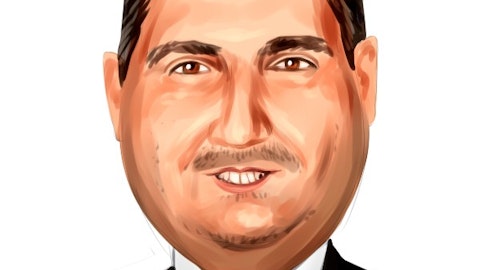Flex Ltd. (NASDAQ:FLEX) Q4 2023 Earnings Call Transcript May 10, 2023
Flex Ltd. beats earnings expectations. Reported EPS is $0.6, expectations were $0.51.
Operator: Good afternoon. Thank you for standing by. Welcome to Flex’s Fourth Quarter and Fiscal 2023 Earnings Conference Call. [Operator Instructions]. I will now turn the call over to Mr. David Rubin, you may begin.
David Rubin: Thank you, Chris. Good afternoon, and welcome to Flex’s Fourth Quarter Fiscal 2023 Earnings Conference Call. With me today is our Chief Executive Officer, Revathi Advaithi; and our Chief Financial Officer, Paul Lundstrom. Both will give brief remarks followed by Q&A. Slides for today’s call as well as a copy of the earnings press release and summary financials are available on the Investor Relations section at flex.com. This call is being recorded and will be available for replay on our corporate website. As a reminder, today’s call contains forward-looking statements, which are based on our current expectations and assumptions. These statements involve risks and uncertainties that could cause actual results to differ materially.
For a full discussion of these risks and uncertainties, please see the cautionary statements in our presentation press release or in the Risk Factors section in our most recent filings with the SEC. Note this information is subject to change, and we undertake no obligation to update these forward-looking statements. Lastly, please note, unless otherwise stated, all results provided will be non-GAAP measures, unless otherwise all growth metrics will be on a year-over-year basis — the full non-GAAP to GAAP reconciliations can be found in the appendix slides of this presentation as well as in the summary financials posted on the Investor Relations website. Now I’d like to turn the call over to our CEO. Revathi?
Revathi Advaithi: Thank you, David. Good afternoon, and thank you for joining us today. Starting with our fiscal Q4 results on Slide 4. Overall, it was another solid quarter. Our revenue grew 9% year-over-year with growth in our reliability, agility and NEXTracker segments. Adjusted operating margin came in at 4.9%, and we delivered $0.57 of adjusted EPS, which was a new record for fiscal Q4. Looking at the full year results, fiscal ’23 was very strong despite the continuing challenges in the macroeconomic landscape. We grew revenue 17% year-over-year with adjusted operating margins for the full year at 4.8%. And we delivered adjusted EPS of $2.36, up — up 20%. That’s the third year in a row EPS has grown at least 20%. Clearly, we can see the progress we have made by executing on our strategy.
Turning to Slide 5. We got a lot done this year. We completed the NEXTracker IPO, getting the pricing and timing right for a great showing despite what is still a very tough IPO market. Looking across the organization, we had another record year in automotive wins. Not only has automotive revenue grown 40% over the last 2 years, but the composition continues to shift to next-gen mobility with an increasing percentage of our wins being design-led. In the business areas we’re targeting, we are providing industry-leading design and engineering capabilities to secure long-term wins and build customer trust. Now this is also true for our wins in the healthcare space. As medical devices become smarter and more complex, OEMs are looking to increase their outsourced manufacturing to help navigate this complexity.
Our extensive experience and capabilities and highly complex automation and global scale, position us well to help health care customers succeed in this changing landscape. As with our automotive business, our design and engineering capabilities and track record of serving leading health care brands give us a competitive market advantage. We had exceptionally strong growth in our cloud business this year as we ramp new hyperscale cloud programs. Our vertical integration, advanced technology capabilities and scale help drive these opportunities, and we have 1 with multiple hyperscale cloud partners. Other notable trends this year include our growth in renewable energy-related hardware from inverters to EV chargers, accelerated by the global shift to clean energy.
We also see increasing demand from the U.S. IRA passage, creating additional opportunity to help our customers take advantage of this growing market. Now turning to supply chain. We continue to navigate the ongoing challenges in supply constraints during the fiscal year. However, we did see improvements in many areas as the year progressed. While there is still the occasional challenge, which is a part of our everyday business, the most significant supply issue remaining is the constraints with larger node semiconductors that primarily affect our reliability segment. Regionalization remains an important topic as companies strive for efficiency and resiliency. There’s a lot of complexity here, and that topic often gets oversimplified. Our core value proposition is that we connect, design and advance manufacturing, supported by vertical integration and complex supply chains.
Then we bring circular economy capabilities such as refurbishment and recycling to minimize waste. And we do this in every major theater of operation, which is critical to regionalization. Because at the heart of it, regionalization is about moving production closer to consumption, adding resilience to the value chain and addressing sustainability concerns. Flex has a strong track record of helping customers optimize their outsourced manufacturing and services, guiding them on what products should be produced where and balancing the dimensions of technology, labor and supply. We are very well positioned to help companies reduce risk, decrease time to market and become more resilient. A good example is in our lifestyle business, which significantly outperformed weak consumer end markets in fiscal ’23 from targeted wins and share gains.

Photo by Umberto on Unsplash
Many of these wins came from our ability to regionalize our customers’ manufacturing and deliver in multiple geographies. Overall, we’ve done very well managing through this cycle, and that is reflected in our fiscal year performance. We have built strong relationships with our customers and our suppliers, increased our opportunities for growth and implemented new capabilities across our operations that make us even stronger and more resilient going forward. Now turning to Slide 6. Our accomplishments and contributions are being recognized by our customers and industry groups that acknowledge Flex as a leader in advanced manufacturing technology as well as our efforts to deliver for our customers in a responsible and sustainable manner. I’m very proud of what we have accomplished.
Paul will provide guidance in just a moment, but I want to make a few comments as we look ahead to fiscal 2024. As you’re well aware, it’s a highly dynamic environment, and there is increasing uncertainty with general concerns on recession, interest rates and geopolitical dynamics. However, we always want to provide the most transparency we can based on our visibility into current customer demand. We will manage through this environment as we have through all the challenges of the last several years. Looking past the near-term macro uncertainty, we believe the fundamentals of outsourced manufacturing remain very strong. Our value proposition and our ability to manage through the cycles positions us well for the future. With that, I’ll turn it over to Paul to take you through the financials.
Paul?
Paul Lundstrom: Okay. Thank you, Revathi, and good afternoon, everyone. I’ll begin with our fourth quarter performance on Slide 8. Fourth quarter revenue was $7.5 billion, up 9%. Gross profit totaled $594 million and gross margin improved 60 basis points to 7.9%. Operating profit was $364 million, with operating margins at 4.9%, improving 60 basis points year-over-year. And earnings per share came in at $0.57 for the quarter, an increase of 10%. Turning to our fourth quarter segment results on the next slide. Reliability revenue increased 14% to $3.2 billion. Operating income was $142 million, up 1% and operating margin for this segment was 4.4%. Revenue growth was strong. However, the program investments and labor inflation, we mentioned last quarter continued to pressure margins in the segment.
We expect reliability margins to progressively improve over the next several quarters. In Agility, revenue was $3.7 billion, up 5%. Operating income was $171 million, up 13% and strong execution and cost management drove an impressive 4.6% operating margin. Finally, NEXTracker revenue came in at $519 million, up 18% year-over-year. Operating income at NEXTracker was $70 million, 3x the level it was last year with operating margins now at 13.5%. Looking at our full year results on Slide 10. Revenue was $30.3 billion, up 17%. Gross profit totaled $2.3 billion and gross margin improved to 7.7%. Operating income for the fiscal year 2023 totaled $1.4 billion, up 23% with a record 4.8% operating margin. For the full year, Flex achieved EPS of $2.36, up 20%.
It’s worth pointing out the greater than typical differential between our GAAP and non GAAP earnings was primarily due to the NEXTracker IPO-related charges. On Slide 11, we have a performance by business unit for the full year. Reliability revenue was $12.7 billion, with operating margin finishing at 4.8%. Within reliability, automotive revenue was up 22%, primarily driven by new project ramps for our next-gen mobility portfolio. Health solutions was up 9%, and industrial was up 24%, aided by very strong growth in renewable energy, hardware EV charging and data center power. Overall, the solid double-digit growth in this segment is representative of the strength of our comprehensive portfolio. The Agility segment revenue came in at $15.8 billion, delivering a 4.4% operating margin.
This strong operating margin is reflective of our strategy to focus our efforts on more profitable business, as well as strong cost management on slowing in consumer markets. Within Agility, CEC was up 30%, resulting from new cloud wins along with portfolio exposure to critical infrastructure like security and networking. Consumer devices revenue was down as expected, reflective of the consumer end market weakness. And finally, lifestyle revenue increased 2% as share gains drove better than market performance more than offsetting softer consumer spending. NEXTracker completed the year with revenue of $1.9 billion, a year-over-year improvement of 31% and ended the year with a 10.7% operating margin, over 4 points higher than the prior year. Overall, we were pleased with our performance and our ability to deliver strong sales and profit growth in a challenging year.
Moving on to cash flow on Slide 12. We saw inventory improvements in Q4 with net working capital advances down — with inventory net of working capital advances down 8% sequentially. Total gross inventory also dropped this quarter by about $300 million. We continue to see improving signs here. However, we’re still managing through shortages and extended lead times for some materials, so we expect inventory will be slow to unwind in the near term. Q4 net CapEx totaled $180 million, and for the full year came in at $615 million on target at 2% of revenue. We expect similar investment levels in our fiscal 2024. Free cash flow was $270 million for the quarter and $335 million for the full year. We expect stronger cash generation in FY ’24 as the severity of the component shortages improves.
Free cash flow in 2024 should be $600 million or more. In terms of financing and capital structure, we made some minor debt repayments in Q4, retiring the $79 million Indian CapEx loan and a EUR 250 million term loan. That’s north of $300 million in debt retirement, but you won’t see that in consolidation as we put $150 million of debt on to NEXTracker as part of their IPO. Maybe a couple of comments on our cash balance before we turn to capital allocation. Cash on hand at $3.3 billion is solid and more than we would typically carry. The elevated level is a product of 2 things: one, buffer cash given the level of cash cycle volatility created by global component shortages, a situation which, as we have mentioned, is beginning to improve; and two, proceeds from the NEXTracker IPO were significant, about $700 million.
I’ll add, we do not plan to carry this elevated level of cash indefinitely. Turning to Slide 13. We remain focused on our capital allocation priorities, including investing in future growth and return of capital. We bought back $44 million worth of stock in the quarter and $337 million for the full fiscal year. Please turn to Slide 14 for our segment outlook for the fiscal first quarter. For Reliability Solutions, we expect mid-single to low double-digit revenue growth for the segment, driven by growth across all 3 business units based on continuing longer-term secular trends. Revenue and Agility will be down mid-single to low double digits with consumer end market weakness affecting both lifestyle and consumer devices, offsetting modest growth expected in CEC.
On to Slide 15 for our quarterly guidance, we expect revenue in the range of $7 billion to $7.5 billion with adjusted operating income between $320 million and $350 million. Interest and other expenses estimated to be around $52 million in the quarter, and we expect the tax rate to be around 13%. So for the quarter, we’re expecting growth from OP at the midpoint with some pressure from interest and taxes. All that translates to adjusted EPS between $0.47 and $0.53 a share based on approximately 459 million weighted average shares outstanding. This guidance includes the impact of approximately $0.03 to $0.04 of noncontrolling interest resulting from the NEXTracker IPO. Looking at our full year guidance on the following slide. It’s a very dynamic macro right now.
However, based on our current demand indicators for reliability, we expect the positive trends we described in Q1 to continue through the year. For Agility, we also expect the challenging environment to continue beyond Q1 with some potential improvements late in the year. We expect NEXTracker to continue to grow based on their strong positioning in the utility solar space. We currently expect full year revenue between $30.5 billion and $31.5 billion, adjusted operating margin between 4.9% and 5.1%, and adjusted EPS and between $2.35 and $2.55 a share. This includes, as Q1 does, approximately $0.17 to $0.19 of noncontrolling interest again resulting from the NEXTracker separation. To close, I’d just like to reiterate our confidence in the strategy to deliver against our longer-term goals.
Over the last 3 years, we’ve demonstrated how we can manage through many challenges, improve our portfolio and still deliver double-digit annual EPS growth. So we’ll manage through this current backdrop and remain focused on creating long-term value for our stakeholders. I’ll now turn the call back over to Chris to begin Q&A.
See also Military Spending by Country in 2023: 20 Largest Defense Budgets and 10 Best Stocks to Buy for a Quick Return.
Q&A Session
Follow Flex Ltd. (NASDAQ:FLEX)
Follow Flex Ltd. (NASDAQ:FLEX)
Operator: [Operator Instructions]. Our first question comes from Steven Fox, Fox Advisors.
Operator: Our next question comes from Mark Delaney, Goldman Sachs.
Operator: Our next question comes from Ruplu Bhattacharya, Bank of America.
Operator: Our next question comes from Matt Sheerin, Stifel.
Operator: [Operator Instructions]. Our next question comes from Shannon Cross, Credit Suisse.
Operator: The last question comes from Paul Chung, JPMorgan.
Operator: There are no further questions at the time. Please proceed.
Revathi Advaithi: Thank you. So on behalf of the Flex leadership team, I just wanted to give a thank you to all our customers and our shareholders for your support. And then I want to thank the Flex team across the globe for continuing to work and their dedication and contributions to the business. So thank you all. Thanks for joining us today.
Operator: Thank you. This concludes today’s conference call. Thank you for joining. You may now disconnect.





